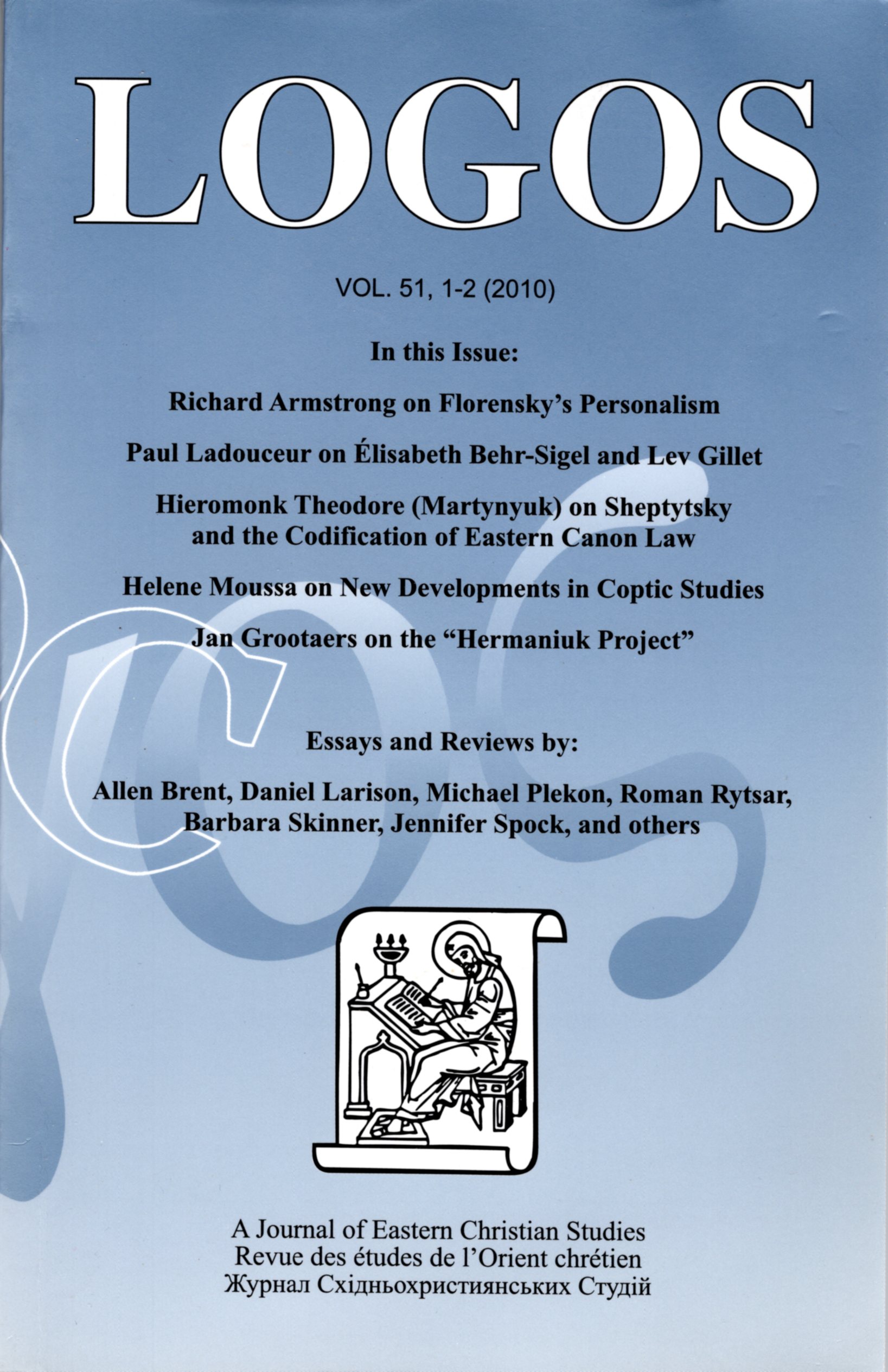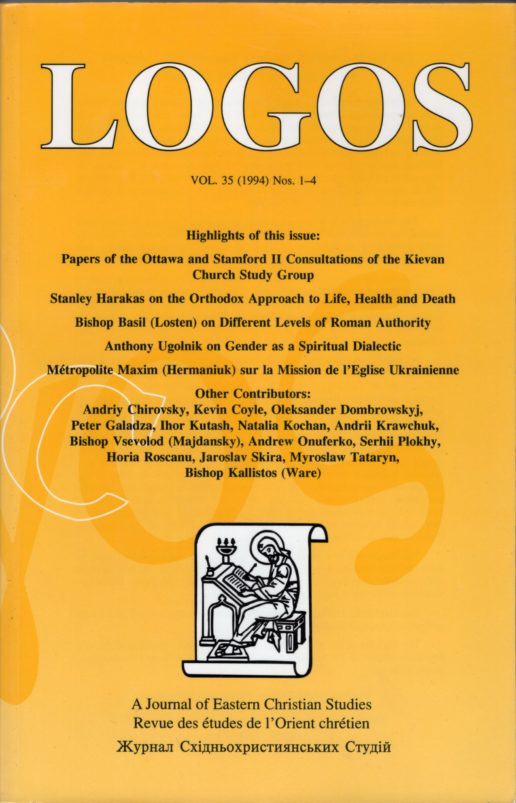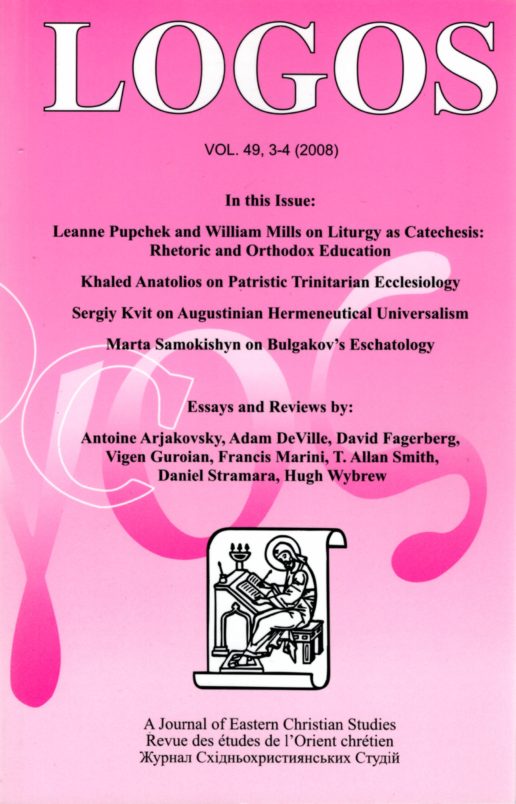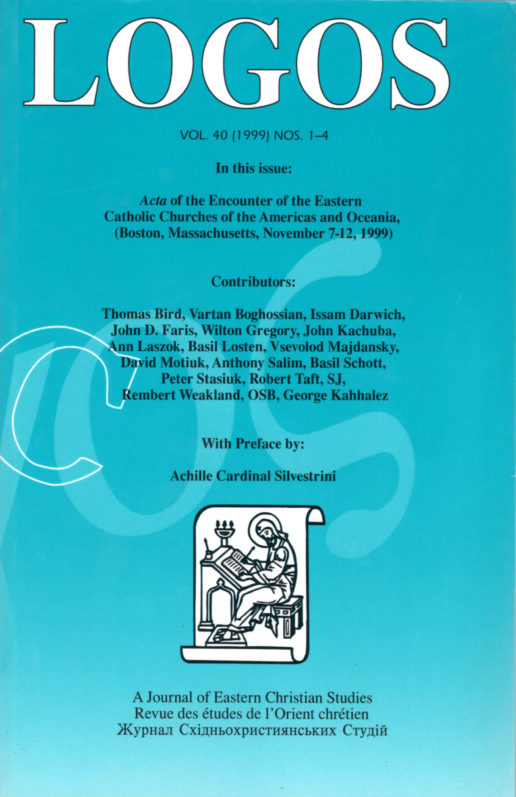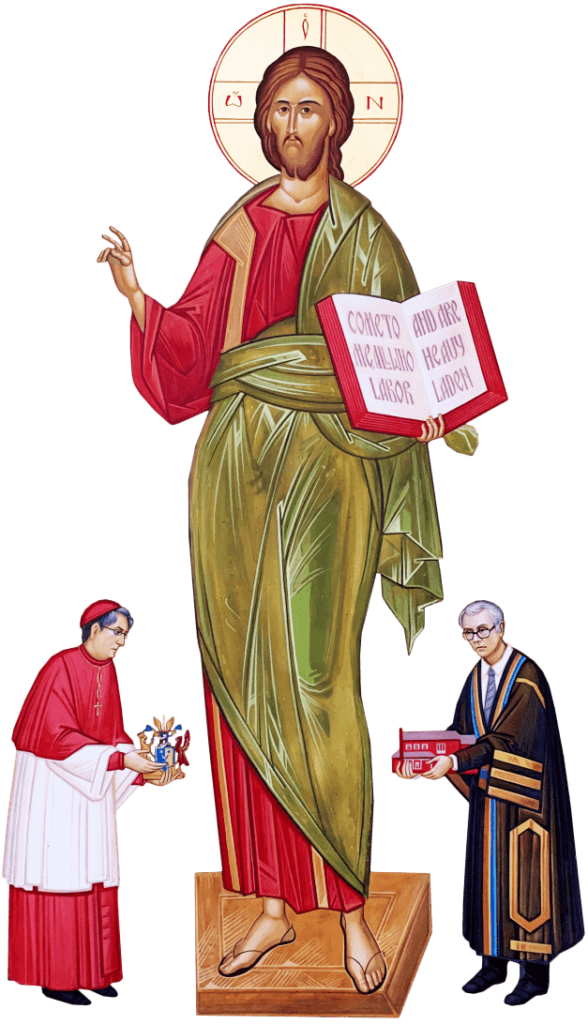Description
Table of Contents (PDF)
Editorial
Rome’s Congregation for the Doctrine of the Faith and Ukrainian Ecumenism: A Plea for Clarity (PDF sample)
Peter Galadza (1)
Articles
Pavel Florensky’s Personalism (PDF sample)
Richard Armstrong (5)
Abstract
In this paper, the author examines the scarcely studied theme of personalism in Pavel Florensky’s magnum opus, The Pillar and Ground of the Truth. Florensky’s ontology of the person is set in the context of several genetic influences: the fourfold intellectual Sitz im Leben of Slavophilism, Romanticism, Symbolism and Sophiology, followed by the threefold thought nexus of Johann Gottlieb Fichte, Henri Bergson, and St. Bernard of Clairvaux. Florensky’s personalist metaphysics is then unpacked through the medium of eight categories: (1) Dynamic-Numeric Identity vs. Generic Identity; (2) Homoousios vs. Homoiousios; (3) The Trinity as Ground and Model; (4) Relationality; (5) Love; (6) Participation; (7) Incommunicability; and (8) Creative Self-Positing. The study culminates with a global overview of Florensky’s antecedent contributions to the foundations of personalism and his relevance for the twentieth-century personalist movement. The author concludes that the Russian prodigy Florensky is yet to receive his laurel as one of the most significant personalists of contemporary times.
Резюме
У цьому дослідженні автор вивчає тему персоналізму у фундаментальній праці Павла Флоренського Стовп і Утвердження Істини. Онтологія особи у працях Фло-ренського розглядається в контексті кількох притаманних йому впливів: Слов’янофільства, Романтизму, Символізму та Софіології з одного боку та синтезом Йоганна Ґотліба Фіхте, Генрі Берґсона та святого Бернарда з Клерво з дру-гого. Потім персоналістична метафізика Флоренського розгортається з допомогою восьми категорій: (1) динаміч-но-цифрової тотожності на противагу звичайній тотожнос-ті, (2) Homoousios на противагу Homoiousios, (3) Трійці як Фундаменту і Моделі, (4) Співвідношеності (5) Любові, (6) Участі, (7) Непередаванності та (8) Творчому самовия-вленню. Дослідження завершується загальним оглядом попереднього доробку Флоренського стосовно фундамен-ту персоналізму та його відношення до персоналістського руху ХХ століття. Автор доходить висновку, що геній Флоровського ще буде визнаний одним з найбільш знач-них персоналістів нашого часу.
Amour en Christ: Élisabeth Behr-Sigel et Lev Gillet (PDF sample)
Paul Ladouceur (45)
Abstract
Neither Élisabeth Behr-Sigel nor Lev Gillet were born Orthodox, but both found their way into the Orthodox Church and then into a unique relationship with each other that was both more intimate and yet more distant than that of a mere friendship. It was a relationship of “amour propre,” that is a love that was genuine and proper but restrained and appropriate because both knew their love could only exist insofar as it came from a love of Christ, who was always primary. Later this relationship would also develop into one of biographer and subject as Behr-Sigel wrote about Gillet after his death in 1980. Their correspondence is here analyzed and situated in biographical and historical context, aided by use of Behr-Sigel’s journals as well as recent studies on each, including those of Olga Lossky, Peter Galadza, and Catherine AubéÉlie. Classic Eastern Christian works on spiritual paternity are also used to give deeper insights into a unique relationship of two singular, strong, deeply human individuals who were nonetheless spiritual father and spiritual “child.”
Резюме
Єлизавета Бер-Сіжель та Лев Жіллє не були народжені православними, однак обоє знайшли свій шлях до Право-славної Церкви а потім і до особливих стосунків між со-бою. Стосунків, які були більш близькими і водночас більш віддаленими ніж просто дружба. Це були стосунки «чистої любові» яка була автентичною і чистою оскільки обоє знали, що їхня любов може існувати лише доти, доки вона походить від любові до Христа, який завжди зали-шався у центрі. Пізніше вони набули динаміки стосунків між біографом та її суб’єктом – Бер-Сіжель написала про Жіллє після того як він упокоївся в 1980 році. Мета цієї праці – аналіз їхньої кореспонденції в біографічному та історичному контексті з допомогою нотаток Бер-Сіжель та нещодавніх досліджень Ольги Лосської, Петра Ґаладзи та Катерини Обе-Елі а також класичних східно-християн-ських творів про духовне наставництво, які дозволяють краще зрозуміти ці унікальні стосунки між двома окреми-ми, сильними і глибоко людяними особистостями – сто-сунки, які все ж таки були стосунками між духовним наставником і духовною «дитиною».
Участь митрополита Андрея Шептицького в опрацюванні принципів кодифікації східного канонічного права Ієромонах Теодор (PDF sample)
Тарас Мартинюк (67)
Abstract
This article examines the role of Metropolitan Andrey Sheptytsky, primate of the Ukrainian Greco-Catholic Church from 1901 until his death in 1944, in updating and codifying Eastern canon law. The codification process to which Sheptytsky made early contributions would continue long after his death, and only begin to come to fruition in 1990 with the publication of the Code of Canons of the Eastern Churches (CCEO). That code, however, is a general code for all the Eastern Catholic Churches: the process of writing particular law for the Ukrainian Greco-Catholic Church, and the scholarly study of the same, remains an ongoing project.
Резюме
Ця стаття досліджує ролю Митрополита Андрея Шептицького, первоієрарха Української Греко-Католиць-кої Церкви (від 1901 року до його упокоєння в 1944 році) в оновленні та кодифікації Східного канонічного права. Цей проєкт стосувався не лише Церкви Шептицького але й інших Церков, що послуговуються власним канонічним правом перебуваючи у єдності з Римом. Процес кодифіка-ції започаткований Шептицьким тривав ще довгий час після його упокоєння. До нього долучилися серед інших І. Жужек, Н. Руснак, С. Королевський, Д. Салакас, Е.Г. Фа-руджа чиї праці будуть використані при аналізі проєкту розпочатого Шептицьким і завершеного у 1990 році пуб-лікацією Кодексу Канонів Східних Церков (ККСЦ). Треба зазначити, що цей Кодекс є загальним збірником для усіх Східних Католицьких Церков тоді як процес написання власних канонів для Української Греко-Католицької Церкви а також його наукове обґрунтування триває. ККСЦ залишається тимчасовим кодексом в очікуванні повної єдності між православними і католиками.
Notes, Essays, Lectures
Coptic Studies Growing in Canada
Helene Moussa (99)
La Genèse du Projet “Hermaniuk” – une Esquisse (PDF sample)
Jan Grootaers (101)
The First International Conference on the Spiritual Legacy of Metropolitan Anthony of Sourozh [Духовное наследие митрополита Антония Сурожского: Материалы первой Международной конференции 28–30 сентября 2007 г. Москва] (PDF sample)
Roman Rytsar (107)
La manifestation des énergies incréées par l’Esprit selon Grégoire Palamas (PDF sample)
Jacques Lison (113)
Appel aux théologiens des Églises de tradition Kiévienne Société Scientifique de Théologie d’Ukraine (123) (PDF sample)
Молитва Ефремова: Аналіз тексту і перекладів (PDF sample)
о. Петро Качур (137)
Book Reviews
Job Getcha, Le Typikon Décrypté, Manuel de liturgie byzantine
Michael Plekon (157)
Peter Galadza, Unité en Division: Les lettres de Lev Gillet, “un moine de L’Église d’Orient,” à Andrei Cheptytsky 1921–1929
Michael Plekon (159)
Thomas A. Robinson, Ignatius of Antioch and the Parting of the Ways: Early Jewish-Christian Relations
Allen Brent (163)
Robert Romanchuk, Byzantine Hermeneutics and Pedagogy in the Russian North: Monks and Masters at the Kirillo-Belozerskii Monastery, 1397–1501
Jenn Spock (167)
Mary B. Cunningham and Elizabeth Theokritoff, eds., The Cambridge Companion to Orthodox Christian Theology William Mills (173), Gillian Crow, Orthodoxy for Today
Roman Rytsar (175)
Tia M. Kolbaba, Inventing Latin Heretics: Byzantines and the Filioque in the Ninth Century
Daniel Larison (178)
John Garrard and Carol Garrard, Russian Orthodoxy Resurgent: Faith and Power in the New Russia
Barbara Skinner (182)
David Bentley Hart, Atheist Delusions: The Christian Revolution and Its Fashionable Enemies
Jason Charron (186)
Miri Rubin, Mother of God: A History of the Virgin Mary Gloria
Falcao Dodd (189)
Briefly Noted (193)
Marcos A. Marcos, Helene Moussa, Carolyn Ramzy, Marguerite Nakhla: Legacy to Modern Egyptian Art (Scarborough, ON: St. Mark’s Coptic Museum, 2009), vi + 135 pp.
Gawdat Gabra, The A to Z of the Coptic Church (Lanham, MD: Scarecrow Press, 2008), xvi + 332 pp.
Stuart Robinson with Peter Botross, Defying Death: Zakaria Botross – Apostle to Islam (Upper Mt. Gravatt, Australia: City Harvest Publications, 2008), vi + 152 pp.
Tim Vivian, ed., Becoming Fire: Through the Year with the Desert Fathers and Mothers (Collegeville, MN: Cistercian/Liturgical Press, 2008), 556 pp.
Paul Avis, Beyond the Reformation: Authority, Primacy, and Unity in the Conciliar Tradition (London/New York: T&T Clark, 2008), xx + 234 pp.
William C. Mills, The Prayer of St. Ephrem the Syrian: a Biblical Commentary (Rollinsford, New Hampshire: Orthodox Research Institute, 2009), xiii + 71 pp.
Susan Wessel, Leo the Great and the Spiritual Rebuilding of a Universal Rome (Leiden: Brill, 2008), xii + 422 pp.
Stanley Hauerwas, The State of the University: Academic Knowledges and the Knowledge of God (Oxford: Blackwell, 2007), 222 pp.
Bruno Forte, The Portal of Beauty: Towards a Theology of Aesthetics, trans. David Glenday and Paul McPartlan (Grand Rapids, MI: Eerdmans, 2008), viii + 121 pp.
Gerard Mannion and Lewis S. Mudge, eds., The Routledge Companion to the Christian Church (New York and London: Routledge, 2008), xx + 684 pp.
Paul D. Murray, ed., Receptive Ecumenism and the Call to Catholic Learning: Exploring a Way for Contemporary Ecumenism (Oxford: Oxford University Press, 2008), xxxv + 534 pp.
Laurent A. Cleenwerck, His Broken Body: Understanding and Healing the Schism between the Roman Catholic and Eastern Orthodox Churches (Washington, DC: Euclid University Consortium Press, 2007), 443 pp.
Adam A.J. DeVille
University of St. Francis
Fort Wayne, IN
Contributors (204)
Language: English, French, Ukrainian
Softcover: vi, 224 pages
Publisher: The Metropolitan Sheptytsky Institute of Eastern Christian Studies
ISSN: 0024-5895
Digital File: $15
Size: 2 MB
A link to the PDF file of this title will be sent to you. The PDF file is for your personal use only. You may not copy, share, publish, or sell the file. Protected by copyright of the Metropolitan Andrey Sheptytsky Institute of Eastern Christian Studies.

